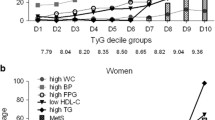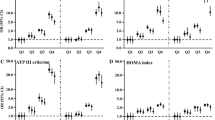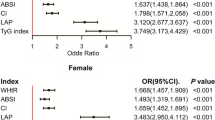Abstract
Purpose
People with the metabolically obese normal weight (MONW) phenotype are considered as an extremely high-risk group for unfavorable health consequences, but they are frequently undetected due to deceptive body mass index (BMI) and complex assessment. This study aimed to explore the clinical usefulness of cardiometabolic index (CMI) in identifying MONW individuals.
Methods
This cross-sectional study involved a total of 47,683 normal-weight subjects aged ≥ 18 years. Participants underwent anthropometrics, routine biochemical tests, and questionnaires for a full evaluation of the metabolic profile. The odds ratio (OR) of CMI and MONW phenotype was determined by the Logistic regression models and the diagnostic accuracy of CMI was evaluated by the receiver operating characteristic (ROC) curve analysis.
Results
The prevalence of MONW phenotype was 11.0%. After multivariate adjustment, the ORs for MONW in the highest compared with the lowest quartile of CMI was 71.20 (95% CI 55.19–91.86), and 1-SD increment of CMI brought a 54% additional risk. In ROC analysis, compared with BMI and waist circumference, CMI showed superior performance for identifying MONW individuals with an AUC of 0.853 (95% CI 0.847–0.860) in men and 0.912 (95% CI 0.906–0.918) in women, respectively. Moreover, CMI exhibited the highest diagnostic accuracy in younger age groups (aged 18–34 for men; aged 18–34 and 35–44 for women), in which AUCs surpassed 0.9 in both sexes.
Conclusions
CMI could be served as a valuable indicator to identify MONW phenotype of Chinese adults, particularly for young people.


Similar content being viewed by others
Availability of data
Data sharing is available upon request to the corresponding author.
References
Di Angelantonio E, Bhupathiraju ShN, Wormser D, Gao P, Kaptoge S, Berrington de Gonzalez A, Cairns BJ, Huxley R, Jackson ChL, Joshy G, Lewington S, Manson JE, Murphy N, Patel AV, Samet JM, Woodward M, Zheng W, Zhou M, Bansal N, Barricarte A, Carter B, Cerhan JR, Smith GD, Fang X, Franco OH, Green J, Halsey J, Hildebrand JS, Jung KJ, Korda RJ, McLerran DF, Moore SC, O'Keeffe LM, Paige E, Ramond A, Reeves GK, Rolland B, Sacerdote C, Sattar N, Sofianopoulou E, Stevens J, Thun M, Ueshima H, Yang L, Yun YD, Willeit P, Banks E, Beral V, Chen Z, Gapstur SM, Gunter MJ, Hartge P, Jee SH, Lam TH, Peto R, Potter JD, Willett WC, Thompson SG, Danesh J, Hu FB (2016) Body-mass index and all-cause mortality: individual-participant-data meta-analysis of 239 prospective studies in four continents. Lancet (Lond, Engl) 388(10046):776–786. https://doi.org/10.1016/s0140-6736(16)30175-1
Wang B, Zhuang R, Luo X, Yin L, Pang C, Feng T, You H, Zhai Y, Ren Y, Zhang L, Li L, Zhao J, Hu D (2015) Prevalence of metabolically healthy obese and metabolically obese but normal weight in adults worldwide: a meta-analysis. Horm Metab Res 47(11):839–845. https://doi.org/10.1055/s-0035-1559767
Stefan N, Schick F, Haring HU (2017) Causes, characteristics, and consequences of metabolically unhealthy normal weight in humans. Cell Metab 26(2):292–300. https://doi.org/10.1016/j.cmet.2017.07.008
Lee SH, Ha HS, Park YJ, Lee JH, Yim HW, Yoon KH, Kang MI, Lee WC, Son HY, Park YM, Kwon HS (2011) Identifying metabolically obese but normal-weight (MONW) individuals in a nondiabetic Korean population: the Chungju Metabolic disease Cohort (CMC) study. Clin Endocrinol 75(4):475–481. https://doi.org/10.1111/j.1365-2265.2011.04085.x
Kramer CK, Zinman B, Retnakaran R (2013) Are metabolically healthy overweight and obesity benign conditions?: a systematic review and meta-analysis. Ann Intern Med 159(11):758–769. https://doi.org/10.7326/0003-4819-159-11-201312030-00008
Luo D, Liu F, Li X, Yin D, Lin Z, Liu H, Hou X, Wang C, Jia W (2015) Comparison of the effect of 'metabolically healthy but obese' and 'metabolically abnormal but not obese' phenotypes on development of diabetes and cardiovascular disease in Chinese. Endocrine 49(1):130–138. https://doi.org/10.1007/s12020-014-0444-2
Choi KM, Cho HJ, Choi HY, Yang SJ, Yoo HJ, Seo JA, Kim SG, Baik SH, Choi DS, Kim NH (2013) Higher mortality in metabolically obese normal-weight people than in metabolically healthy obese subjects in elderly Koreans. Clin Endocrinol 79(3):364–370. https://doi.org/10.1111/cen.12154
Yoo HJ, Hwang SY, Hong HC, Choi HY, Seo JA, Kim SG, Kim NH, Choi DS, Baik SH, Choi KM (2014) Association of metabolically abnormal but normal weight (MANW) and metabolically healthy but obese (MHO) individuals with arterial stiffness and carotid atherosclerosis. Atherosclerosis 234(1):218–223. https://doi.org/10.1016/j.atherosclerosis.2014.02.033
Chooi YC, Ding C, Chan Z, Choo J, Sadananthan SA, Michael N, Lee Y, Velan SS, Magkos F (2018) Moderate weight loss improves body composition and metabolic function in metabolically unhealthy lean subjects. Obesity 26(6):1000–1007. https://doi.org/10.1002/oby.22185
He W, Li Q, Yang M, Jiao J, Ma X, Zhou Y, Song A, Heymsfield SB, Zhang S, Zhu S (2015) Lower BMI cutoffs to define overweight and obesity in China. Obesity 23(3):684–691. https://doi.org/10.1002/oby.20995
Ding C, Chan Z, Magkos F (2016) Lean, but not healthy: the 'metabolically obese, normal-weight' phenotype. Curr Opin Clin Nutr Metab Care 19(6):408–417. https://doi.org/10.1097/MCO.0000000000000317
Wakabayashi I, Daimon T (2015) The "cardiometabolic index" as a new marker determined by adiposity and blood lipids for discrimination of diabetes mellitus. Clin Chim Acta 438:274–278. https://doi.org/10.1016/j.cca.2014.08.042
Britton KA, Fox CS (2011) Ectopic fat depots and cardiovascular disease. Circulation 124(24):e837–e841. https://doi.org/10.1161/CIRCULATIONAHA.111.077602
Lin D, Qi Y, Huang C, Wu M, Wang C, Li F, Yang C, Yan L, Ren M, Sun K (2018) Associations of lipid parameters with insulin resistance and diabetes: a population-based study. Clin Nutr 37(4):1423–1429. https://doi.org/10.1016/j.clnu.2017.06.018
Li HH, Wang JM, Ji YX, Lin L, Li SW, Cai D, Huang S, Hua F, Liu XZ (2020) Association of visceral adiposity surrogates with impaired fasting glucose in nonobese individuals. Metab Syndr Relat Disord 18(3):128–133. https://doi.org/10.1089/met.2019.0078
Wang H, Sun Y, Li Z, Guo X, Chen S, Ye N, Tian Y, Zhang L (2018) Gender-specific contribution of cardiometabolic index and lipid accumulation product to left ventricular geometry change in general population of rural China. BMC Cardiovasc Disord 18(1):62. https://doi.org/10.1186/s12872-018-0798-0
Wang H, Chen Y, Sun G (2018) Validity of cardiometabolic index, lipid accumulation product, and body adiposity index in predicting the risk of hypertension in Chinese population. Postgrad Med 130(3):325–333. https://doi.org/10.1080/00325481.2018.1444901
Wang H, Chen Y, Guo X, Chang Y, Sun Y (2017) Usefulness of cardiometabolic index for the estimation of ischemic stroke risk among general population in rural China. Postgrad Med 129(8):834–841. https://doi.org/10.1080/00325481.2017.1375714
Lenfant C, Chobanian AV, Jones DW, Roccella EJ (2003) Seventh report of the Joint National Committee on the Prevention, Detection, Evaluation, and Treatment of High Blood Pressure (JNC 7): resetting the hypertension sails. Hypertension 41(6):1178–1179. https://doi.org/10.1161/01.hyp.0000075790.33892.ae
Marathe PH, Gao HX, Close KL (2017) American Diabetes Association Standards of Medical Care in Diabetes 2017. J Diabetes 9(4):320–324
Expert Panel on Detection, evaluation, and treatment of high blood cholesterol in adults (2001) Executive summary of the third report of the National Cholesterol Education Program (NCEP) expert panel on detection, evaluation, and treatment of high blood cholesterol in adults (adult treatment panel III). JAMA 285(19):2486–2497. https://doi.org/10.1001/jama.285.19.2486
Alberti KG, Eckel RH, Grundy SM, Zimmet PZ, Cleeman JI, Donato KA, Fruchart JC, James WP, Loria CM, Smith SC Jr (2009) Harmonizing the metabolic syndrome: a joint interim statement of the International Diabetes Federation Task Force on Epidemiology and Prevention; National Heart, Lung, and Blood Institute; American Heart Association; World Heart Federation; International Atherosclerosis Society; and International Association for the Study of Obesity. Circulation 120(16):1640–1645. https://doi.org/10.1161/circulationaha.109.192644
DeLong ER, DeLong DM, Clarke-Pearson DL (1988) Comparing the areas under two or more correlated receiver operating characteristic curves: a nonparametric approach. Biometrics 44(3):837–845
Zhang Y, Fu J, Yang S, Yang M, Liu A, Wang L, Cao S, Sun X, Wang F, Liu D (2017) Prevalence of metabolically obese but normal weight (MONW) and metabolically healthy but obese (MHO) in Chinese Beijing urban subjects. Biosci Trends 11(4):418–426. https://doi.org/10.5582/bst.2017.01016
Xia L, Dong F, Gong H, Xu G, Wang K, Liu F, Pan L, Zhang L, Yan Y, Gaisano H, He Y, Shan G (2017) Association between indices of body composition and abnormal metabolic phenotype in normal-weight Chinese adults. Int J Environ Res Public Health. https://doi.org/10.3390/ijerph14040391
Meigs JB, Wilson PW, Fox CS, Vasan RS, Nathan DM, Sullivan LM, D'Agostino RB (2006) Body mass index, metabolic syndrome, and risk of type 2 diabetes or cardiovascular disease. J Clin Endocrinol Metab 91(8):2906–2912. https://doi.org/10.1210/jc.2006-0594
Lee K (2009) Metabolically obese but normal weight (MONW) and metabolically healthy but obese (MHO) phenotypes in Koreans: characteristics and health behaviors. Asia Pac J Clin Nutr 18(2):280–284
Camhi SM, Bray GA, Bouchard C, Greenway FL, Johnson WD, Newton RL, Ravussin E, Ryan DH, Smith SR, Katzmarzyk PT (2011) The relationship of waist circumference and BMI to visceral, subcutaneous, and total body fat: sex and race differences. Obesity (Silver Spring, Md) 19(2):402–408. https://doi.org/10.1038/oby.2010.248
Ashwell M, Gunn P, Gibson S (2012) Waist-to-height ratio is a better screening tool than waist circumference and BMI for adult cardiometabolic risk factors: systematic review and meta-analysis. Obes Rev 13(3):275–286. https://doi.org/10.1111/j.1467-789X.2011.00952.x
Gu Z, Zhu P, Wang Q, He H, Xu J, Zhang L, Li D, Wang J, Hu X, Ji G, Zhang L, Liu B (2018) Obesity and lipid-related parameters for predicting metabolic syndrome in Chinese elderly population. Lipids Health Dis 17(1):289–289. https://doi.org/10.1186/s12944-018-0927-x
Palmisano BT, Zhu L, Eckel RH, Stafford JM (2018) Sex differences in lipid and lipoprotein metabolism. Mol Metab 15:45–55. https://doi.org/10.1016/j.molmet.2018.05.008
Palmer BF, Clegg DJ (2015) The sexual dimorphism of obesity. Mol Cell Endocrinol 402:113–119. https://doi.org/10.1016/j.mce.2014.11.029
Wells JCK, Treleaven P, Cole TJ (2007) BMI compared with 3-dimensional body shape: the UK National Sizing Survey. Am J Clin Nutr 85(2):419–425. https://doi.org/10.1093/ajcn/85.2.419
Tom SE, Cooper R, Patel KV, Guralnik JM (2012) Menopausal characteristics and physical functioning in older adulthood in the National Health and Nutrition Examination Survey III. Menopause 19(3):283–289. https://doi.org/10.1097/gme.0b013e3182292b06
Ortega FB, Lavie CJ, Blair SN (2016) Obesity and cardiovascular disease. Circ Res 118(11):1752–1770. https://doi.org/10.1161/circresaha.115.306883
Acknowledgements
We gratefully acknowledge all the participants in this study along with of the Third Xiangya Hospital for their assistance in collecting and examining the biochemical samples.
Funding
This study was supported by the National Natural Science Foundation of China (81770403) and the National Social Science Foundation of China (17AZD037).
Author information
Authors and Affiliations
Corresponding authors
Ethics declarations
Conflicts of interest
The author reports no conflicts of interest in this work.
Ethical approval
This article does not contain any studies with human participants or animals performed by any of the authors.
Informed consent
No informed consent.
Additional information
Publisher's Note
Springer Nature remains neutral with regard to jurisdictional claims in published maps and institutional affiliations.
Electronic supplementary material
Below is the link to the electronic supplementary material.
Rights and permissions
About this article
Cite this article
Liu, X., Wu, Q., Yan, G. et al. Cardiometabolic index: a new tool for screening the metabolically obese normal weight phenotype. J Endocrinol Invest 44, 1253–1261 (2021). https://doi.org/10.1007/s40618-020-01417-z
Received:
Accepted:
Published:
Issue Date:
DOI: https://doi.org/10.1007/s40618-020-01417-z




